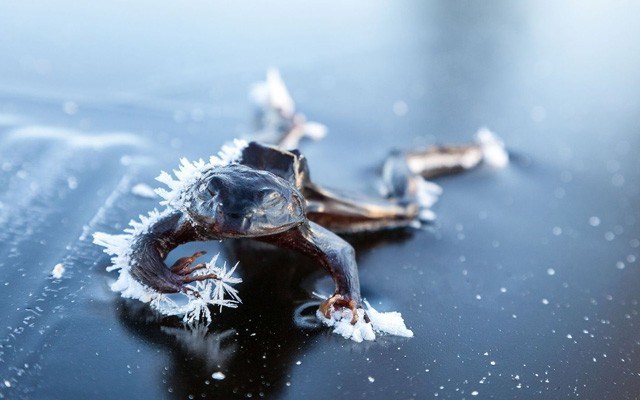Being both a biologist and an avid ski-tourer, I seldom find myself skiing over an ice-covered streams or pond without giving thought to what lies beneath — how do the animals that live in and around water bodies and spend such a large part of their existence entombed in hibernation pull it off? This is particularly true for ectothermic (cold-blooded) animals like reptiles and amphibians, whose survival in Canada's winters has proved a science unto itself.
Animals employ two strategies in seasonally cold climates: freeze avoidance and freeze tolerance. The two share some biochemical and physiological similarities, but whereas simple avoidance (e.g., hibernating below the frost line) is practiced by most animals, tolerance — in which certain tissues actually freeze for varying periods of time — is rarer and correspondingly more complex and interesting. Kenneth B. Storey, professor of biochemistry at Ottawa's Carlton University, knows more about the subject than anyone in the world. Among those amphibians and reptiles he's identified as particularly freeze tolerant in Canada are Cope's gray treefrog (Hyla versicolor), boreal chorus frog (Pseudacris triseriata), wood frog (Rana sylvatica), painted turtle (Chrysemys picta), and the common gartersnake (Thamnophis sirtalis). The most tolerant and best-studied of these is the wood frog, which ranges to treeline in sub-arctic regions of North America including northern B.C. Storey conducted his groundbreaking work on this species over 20 years ago, but what he found borders on incredible.
By hibernating on land, wood frogs become active as soon as the snow melts. Breeding in temporary ponds formed by meltwater, their choruses are heard over a month before aquatic species like green frogs or leopard frogs begin their own noisy breeding. But hibernation on land also has its cost. Frogs can't dig themselves underground like toads do and thus, must hibernate in damp leaf litter to avoid drying out. Their water-permeable skin is no barrier to ice and so, when frost penetrates to their winter home, they simply freeze. Within only hours of the animal being exposed to below-zero temperatures, ice fills all fluid compartments like the abdominal cavity. Large, flat ice crystals run between layers of skin and muscle, and the eyes turn white because the lens freezes. With some 65 per cent of the frog's total body water converted to ice, blood stops flowing, and breathing, heart beat, and muscle movements cease. The "frog-sicle" exists in a state of suspended animation until it thaws.
Freeze tolerance has three main components. The first is control of the freezing process itself. Low temperatures trigger special nucleators to actively seed ice formation in the frog's body (imagine a starter grain on which an ice crystal can grow — much like what happens in snowmaking), allowing animals to begin freezing just below 0C. The second component is production of cryoprotectants — high concentrations of sugars and sugar alcohols that prevent excessive reduction of cell volume and increase the content of bound water. Like the glycols added to our car's radiator for the same purpose, cryoprotectants keep the insides of cells from freezing. Thus, ice forms around internal organs rather than through them, drawing water from them but leaving a thick, syrupy solution inside unfrozen cells. Finally, because the blood is frozen, organs require an elevated ability to survive without regular delivery of oxygen or nutrients; during thawing, antioxidants resist the cellular stress produced when oxygen is suddenly reintroduced, and repair mechanisms go on high alert — for instance, the level of clotting proteins rises to staunch any bleeding from ice-damage to organs.
Behaviour also plays a role. As frogs freeze, they assume the "water-holding" position typically employed by animals to avoid desiccation: head down, limbs drawn in. This position reduces evaporative water loss over what can be weeks of continuous freezing. What hasn't been well-studied are how signals for breathing, heartbeat, and brain activity are reactivated during thawing, when all organ functions miraculously re-boot within two hours.
Though it, too, is somewhat freeze tolerant, the common gartersnake (Thamnophis sirtalis) is no wood frog. Rather, the species is tolerant by degree and with regional variation — northern (and Whistler) populations can handle the freezing of skin and skeletal musculature, but not for periods stretching beyond hours or days. Winters where sub-zero temperatures reach deeply into dens for extended periods still cause massive die-offs. Nevertheless, certain subspecies of T. sirtalis (like the red-sided gartersnake, with notoriety as denizen of Manitoba's famed snake dens, the world's largest concentration of reptiles) have the longest activity season of any North American snake, often roaming the surface with body temperatures lethal to other species: I've seen gartersnakes moving through spring snowfalls, and a friend documented them emerging from a den on the Alberta/Northwest Territory border with internal temperatures as low as 0.5 C, active and crawling across patches of snow.
When it comes to tolerance, frogs and snakes give you something to think about next time you're cold and say: "I'm freezing."
Leslie Anthony is a Whistler-based author, editor, biologist and bon vivant who has never met a mountain he didn't like.




